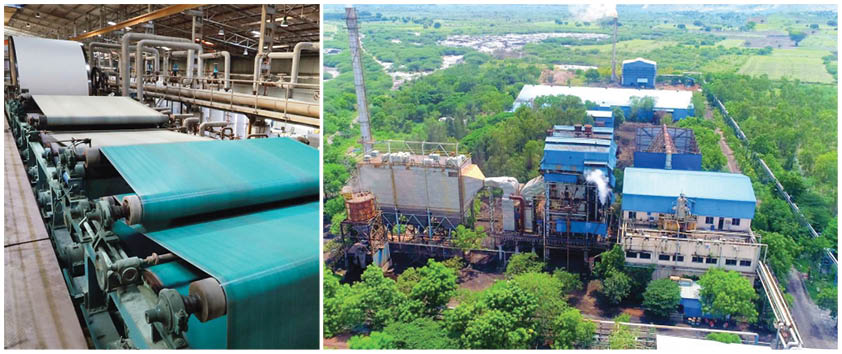In an exclusive interview with Paper Mart, Mr. N. Rama Mohan Murali, Senior VP – Operations, and Mr. Sudarshan Rangaswami, Assistant VP – Finance, outlined Sripathi Paper and Boards Private Limited’s journey from a modest 30 TPD kraft capacity in 2003 to 800 TPD today, making it one of South India’s largest recycled paper and board manufacturers. Under its Vision 2028, the company is targeting 100% renewable energy use to become the world’s first fully sustainable packaging board enterprise. With India’s packaging market growing post-COVID, Sripathi Paper and Boards’s eco-friendly, performance-driven recycled solutions position themselves to meet rising e-commerce, FMCG, and EPR-driven demand.


Paper Mart: Could you begin by giving us an overview of your packaging paper and board operations – including your production capacity, facility locations, and manufacturing setup?
Rama Mohan Murali: Sripathi Paper and Boards, founded in 2003 with a humble 30 TPD kraft capacity, has grown into a robust 800 TPD operation, driven by a strong focus on quality and customer service. The company’s Sivakasi, Tamil Nadu facility houses PM2, a 4-wire, multi-fourdrinier machine with 350 TPD capacity, and PM4 with 150 TPD capacity, together delivering 500 TPD of packaging board. PM1, dedicated to kraft, offers an additional 150 TPD capacity at the same location. Complementing these are writing and printing paper mills with a combined 150 TPD capacity, split between Sivakasi and Satyamangalam. With this scale, Sripathi Paper and Boards stands among the largest single-site recycled paper and paperboard manufacturers in South India.

Post-COVID packaging demand has not only grown but also diversified, with a clear tilt towards eco-friendly, recycled, and performance-optimised grades—areas where Sripathi Paper & Boards has a strong, scalable product portfolio.
PM: Please walk us through your current product portfolio. What grades, GSM ranges, and end-use applications do you cater to, and are there any specialty packaging paper and board products you offer?
Sudarshan Rangaswami: Our PM2 and PM4 capabilities enable us to offer a wide range of packaging board options for discerning customers. The variety which includes- dust-free grey back (nano super), dust-free white back duplex boards (nano gloss ), and eco-FBB (nano green) with a wide GSM range from 180 right up to 450 GSM, enables us to offer a one stop solution shop to our customers. We have specialized offerings for match box, FMCG and food packaging industry such as high bulk boards (nano regular), white top kraft liner, eco-FBB (nano green), dust-free white back (nano gloss) and blister pack.
Watch: In Pursuit of Lesser Water Footprint
PM: Which are your key domestic and international markets? How has your market footprint evolved in the past few years?
RMM: With the bulk of our capacity located in the heart of the printing, fireworks and matchbox making hub of India, our key domestic markets have been Sivakasi, Tamil Nadu, Karnataka, Kerala and Telangana. Our products have made their mark in Sri Lanka, Middle East and African markets catering to both packaging boards as well as writing and printing paper requirements.
Over the years we have significantly increased our presence in Karnataka, Tirupur, Middle East and African markets on the strong foundation of high quality, reasonably priced, customer focussed approach.
PM: Sustainability is becoming a cornerstone of packaging. What steps have you taken to integrate environmentally responsible practices into your manufacturing and sourcing?
SR: At Sripathi Paper and Boards, sustainability is not an afterthought—it is the foundation of our business. As a 100% recycled fibre–based company, we have consistently aligned our operations with global green practices. Today, about 45% of our total energy needs are met from renewable sources, through a well-balanced mix of wind, solar, and biomass. Guided by our Vision 2028, we are on track to increase this to 100%, setting a bold course to become the world’s first fully sustainable board enterprise.
Our commitment to energy efficiency has earned us national recognition, with the CII National Award for Excellence in Energy Management in both 2023 and 2024, designating us as an ‘Energy Efficient Unit’. These achievements are reinforced by global certifications such as GRS (Global Recycled Standard 4.0) and FSC (Forest Stewardship Council), reflecting our dedication to responsible sourcing, manufacturing, and circular economy principles.
Sustainability for us also extends beyond just our processes. We have pledged 25 acres of our own land for the creation of a Miyawaki forest and set aside 100 acres for the cultivation of biomass fuel crops, strengthening our renewable energy capacity. In partnership with like-minded charitable trusts, we are restoring four rainwater lakes in the Thiruthangal area, which had been heavily contaminated by sewage. This project—encompassing dewatering, desilting, and long-term protection against pollution—will restore nearly 2 billion litres of freshwater storage, improving water security for the local community.
Through these integrated initiatives, Sripathi Paper and Boards continues to demonstrate that industrial growth and environmental responsibility can go hand in hand—delivering measurable benefits for the planet, our people, and the communities we serve.

The growth is due to higher e-commerce adoption, growing trend towards smaller SKUs as well as push from brand owners and retailers who are under stronger Extended Producer Responsibility (EPR) compliance obligations, favouring recycled fibre-based boards over plastic packaging.
PM: How has demand for packaging paper and board evolved post-COVID and amid growing e-commerce and FMCG consumption? Which segments are currently driving the most growth for you?
RMM: Post-COVID packaging demand has not only grown but also diversified, with a clear tilt towards eco-friendly, recycled, and performance-optimised grades—areas where Sripathi Paper and Boards has a strong, scalable product portfolio. In India packaging paper and board demand is projected to grow at a CAGR of 6 -7.4%, depending on which source you believe. The growth is due to higher e-commerce adoption, growing trend towards smaller SKUs as well as push from brand owners and retailers who are under stronger Extended Producer Responsibility (EPR) compliance obligations, favouring recycled fibre-based boards over plastic packaging. Sripathi Paper and Boards’s recycled paper solutions fit directly into this shift, offering circular economy benefits without compromising print and conversion performance.
PM: According to recent global market data, the packaging paper and board market is projected to grow steadily through 2033. How are you positioning your business to tap into this rising global demand?
SR: You are right, global market growth projections show increasing consumption, we understand largely from foods and beverages, FMCG and personal care packaging. With the mature markets of Europe and US showing further preference for greener options, increased urbanization combined with awareness of sustainability is changing the nature of preferred products in Asia Pacific markets as well. Sripathi Paper and Boards is well poised to present a credible source of eco-friendly products that are not only made from recycled fibres but also produced using renewable sources of energy and water, the most vital ingredient in paper making.
Thus, we are confident of presenting a stronger use case for evolved discerning brands to choose Sripathi Paper and Boards. We have a wide variety of products ranging from eco-FBB, white top kraft liner, high bulk board, blister pack and white back, that have been developed because of our customer focussed approach and a vision to build a value- added packaging board business.
PM: What are some of the most significant technological upgrades or process improvements you’ve made recently in your mills to enhance quality, reduce waste, or optimize energy usage?
RMM: Continuous process improvements are part of day-to-day life at Sripathi Paper and Boards, our consistently high product quality and repeat customers is a testimony of this effort. In the recent years various technological upgrades have been completed such as glass lined calenderer, blade coater in PM4 and automatic sheeters coupled with vertical stacking and Warehouse Management System (WMS). We have put in place a 3-year upgrade plan as a part of Vision 2028 for Sripathi Paper and Boards that will further reinforce quality superiority of our products.

PM: Are you seeing a shift in customer preference toward higher-strength or lightweight packaging paper and board variants? How are you balancing performance with cost-efficiency in product development?
SR: Value management is a continuous process for most businesses these days specifically to offer better value to end consumers. This has seen a steady shift in preferred GSM in packaging applications. It is precisely in these segments Sripathi Paper and Boards’s product offering such as eco-FBB, white top kraft liner to name a few are helping us gain market share. Our product development has always been focussed on providing better value to converters and thus end users, which cannot be achieved without balancing lighter weight but appropriately stronger materials, using a combination of raw material inputs and process innovations.
PM: What are the major challenges you currently face as a packaging paper and board manufacturer– be it raw material volatility, energy costs, logistics, or regulatory changes? How are you navigating them?
RMM: Disruptions in global supply chains more specifically shipping and volatility in raw material both availability and pricing and increasing energy costs have been some of the key challenges that have affected the industry at large and Sripathi Paper and Boards is not an exception to this. We have put in place systems ranging from inventory management, productivity and energy efficiency and gradual movement towards value added products to navigate these challenges.
Also Read: Star Paper Mills Targets Capacity Expansion and Product Innovation Amid E-Commerce and FMCG Boom
PM: Looking ahead, what’s your strategic roadmap – capacity expansion, backward integration, export push, product diversification? How do you envision your mill’s role in the global packaging paper and board value chain in the next 5 years?
SR: Sripathi Paper and Boards’s strategic road map envisions aligning our capacities to growth segments of the market, continuing to focus on value-added products that offer customers better value. Through Vision 2028, we aim to become the first sustainable board enterprise, we are confident through this positioning as well as our product profile we will have a unique offering in the export markets.

Through Vision 2028 Sripathi Paper and Boards aims to become the first sustainable board enterprise, we are confident through this positioning as well as our product profile we will have a unique offering in the export markets.



